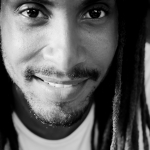A hurricane like no other
Marigot, Saint-Martin, France -- It’s shortly after 4:35 am when I realize that this hurricane is like no other that I have known. I am sitting on the bed in my hotel, fully dressed and with my shoes on, listening to the cacophony all around me and watching the water seeping in.
A hurricane at night is terrible. All you hear are the howls and gusts of wind, the rain and other noises of whose provenance you’re not at all sure. My realization comes two hours after I thought that the worst of the storm had passed.
Around 2 o’clock in the morning, I lay in my bed in my hotel in Saint-Martin and think, that’s it, the worst is over. And then I look on the weather map and see that no, the worst of Irma is yet to come.
An hour or so later, I feel my wooden bunk bed moving. Is it really moving or just me trembling? Turns out it’s the building itself that’s heaving under the force of the bearing wind.
That wind isn’t showing any intention of easing up. It just howls and howls. There are noises everywhere -- not a deafening noise, but a low groan that seems to envelop all around it. So I sit on my bed, looking at the ceiling, the doors, the windows, the water seeping in under the hotel room door, the ceiling again….
 The Hotel Mercure in Marigot during the eye of the storm (top) and after Hurricane Irma had passed.
(AFP / Lionel Chamoiseau)
The Hotel Mercure in Marigot during the eye of the storm (top) and after Hurricane Irma had passed.
(AFP / Lionel Chamoiseau)Just a few days before, my trip to the island had started on a decidedly upbeat note. When my editor called offering for me to go cover the hurricane, it marked the first time that AFP had sent me anywhere. I was excited and stressed. Not stressed because of the hurricane, but because I had very little time to pack.
I packed as quickly as I could, taking things that I thought would be useful -- a long-sleeved synthetic shirt (dries quickly), a charger, a lamp that you can recharge manually. I was in such a hurry that I forgot to take a good pair of sneakers. I ended up covering one of the worst hurricanes in the Atlantic in fashionable leather sneakers.
I am from Martinique and I’ve lived through several hurricanes -- people in the Caribbean are used to them.
Not dwelling on how powerful a category 5 hurricane can be, I also bought a round-trip ticket, thinking that after a few days, the airport would reopen. Never did I imagine that I would be stuck for days… I didn’t realize as I packed just how strong this hurricane was. It was only once I was in the plane that I thought about where I was heading and said to myself “What the hell am I doing? I could die over there.”
 The island of Martinique after Hurricane Maria on September 19, 2017.
(AFP / Lionel Chamoiseau)
The island of Martinique after Hurricane Maria on September 19, 2017.
(AFP / Lionel Chamoiseau)When I got to the island on September 4, I found that most people weren’t too worried. Another hurricane passing through. The next day, however, the ambiance changed, there was more tension in the air. The people no doubt watched a bit more of the news, thought a bit more about what was heading their way. The stores closed one by one, the streets emptied. My colleague Thomas Thurar and I bought a bit more water and basic food “just in case.” But at the same time, we weren’t too worried -- most of the buildings were built to withstand hurricanes, after all. It should be fine, we told ourselves.
Thomas and I got up early the day Irma was to arrive and drove around from 7 am checking out the situation. We decided to go back to the hotel at 4 pm to get some sleep -- Irma was to arrive late in the evening and that way we’d be rested when the brunt of the storm hit.
The hurricane started out softly, with the wind getting stronger and stronger. And at a certain moment you realize that it’s not going to slow down. And at one point you find yourself sitting on your bed fully dressed, listening and watching every sound and movement.
 Preparing ahead of Irma, Marigot, September 5, 2017.
(AFP / Lionel Chamoiseau)
Preparing ahead of Irma, Marigot, September 5, 2017.
(AFP / Lionel Chamoiseau) Preparing for Irma, Marigot, September 5, 2017.
(AFP / Lionel Chamoiseau)
Preparing for Irma, Marigot, September 5, 2017.
(AFP / Lionel Chamoiseau)
When the connection signal goes off on my cell phone, my heart drops a bit -- I can no longer send any news to my fiancee. It’s then that I feel cut off from the world.
I try to figure out why the water is seeping in under the hotel door -- the hallway outside is sheltered and there are two rooms on either side of me… Little by little, it starts getting light outside. Not that you can see much out the window -- gray, rain pouring in horizontal sheets and indiscernible objects passing by at dizzying speed. As I look out the window, I realize that it seems to be breathing. I back away -- you never know. Then I realize that the ceiling seems to be breathing as well. I look from one to another, wondering which one will give way first.
I hear a loud bang and look up -- the roof tiles just gave way. If the isolation goes too, there isn’t going to be much left of the room. Thomas and I quickly get our things. Water is now pouring in from everywhere -- the ceiling, from under the door (as we leave we see that the room opposite ours has been blown to bits, that’s where the water is coming from). We take refuge in the bathroom and it’s there that I finally understand just how powerful this hurricane is -- by listening to the howling in the water pipes; by watching the water rise and fall to the rhythm of the wind gusts and by feeling my ears block up as if I were in a plane.
We have to be vigilant and ready, as the worst may yet to come. Finally we get a moment of respite, as the eye of the storm passes above, and take a look outside -- it’s worse than I could have ever imagined. I realize that Round Two is just around the corner. I'm not sure if the room can withstand it and frankly don't want to find out. We decide to go down to the room of a couple that we met the day earlier. We have to move fast, as the whole shebang could restart at any moment.
 The view during the eye of the storm. (AFP / Lionel Chamoiseau)
The view during the eye of the storm. (AFP / Lionel Chamoiseau)Round Two ended up being much more stressful, because we both knew what was in store, how much the building had already withstood and not at all sure how much more punishment it could take. You can’t imagine the joy and relief that washed over us when we realized that the wind was finally dying down.
When we finally felt safe enough to go out, we also realized the advantage of working in a team to cover a hurricane. While my car was blown to bits, Thomas’s had been spared and so we had the luxury of moving around. It was a Kia Picanto, which is not exactly best suited for driving over roads filled with sand and debris. We didn’t care at all -- it was in driving condition which was in and of itself fairly incredible given the circumstances.
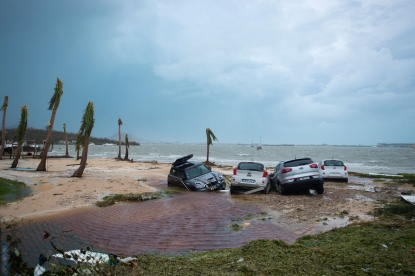 (AFP / Lionel Chamoiseau)
(AFP / Lionel Chamoiseau)As we drove around, I couldn’t believe my eyes. Like I said, I’d lived through several hurricanes. But I’ve never seen this -- -- containers thrown into impossible-to-imagine places, cars bent, covered in nearly a meter of sand, or both. The leaves were gone from all the trees and the hills looked as if they had been burned. Irma had completely redrawn the landscape.
The days after the hurricane we lived on the essentials that we had bought before -- mainly cereal bars and cookies. A few days after the storm we ran into some policemen who were very friendly and gave us some hot food, which really hit the spot. At night, we returned to the hotel to sleep. Since there was little electricity, we returned as soon as it started getting dark. There were a few rooms left intact at the hotel so we squatted in one. It was a bizarre sight to see -- the rooms had the bathrobes, the little bottles of toiletries, the beds perfectly made up… all in complete darkness, surrounded by utter devastation and covered by a few centimeters of water.
A journalist’s lifeline nowadays is electricity -- without it you can’t send your pictures and in that regard we really got lucky. When we went to the police station, we met an officer whose house for some reason still had electricity and -- magic -- the Internet. It was an oasis for us -- Internet, cold beer, we could actually speak to our loved ones. I will forever be grateful to Greg and Sandrine for letting us partake in such a miracle.
 Sandy Town, Saint-Martin, September 7, 2017.
(AFP / Lionel Chamoiseau)
Sandy Town, Saint-Martin, September 7, 2017.
(AFP / Lionel Chamoiseau)The locals had mixed reactions to us. Some were amazed to learn that we were sent by an international news agency just to cover the hurricane. Others told us to take our cameras and shove them you know where.
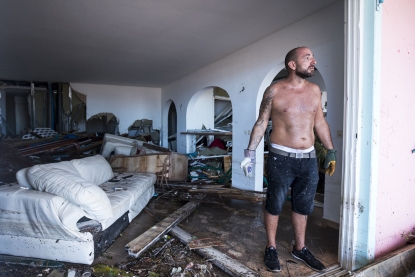 A resident of Orient Bay after Irma had passed.
(AFP / Lionel Chamoiseau)
A resident of Orient Bay after Irma had passed.
(AFP / Lionel Chamoiseau)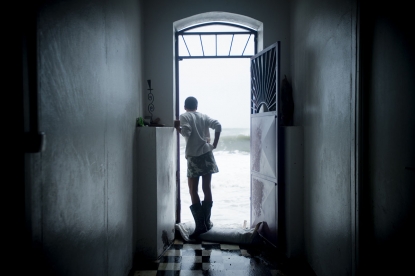 On Martinique after Hurricane Maria passed, September 19, 2017.
(AFP / Lionel Chamoiseau)
On Martinique after Hurricane Maria passed, September 19, 2017.
(AFP / Lionel Chamoiseau)
I don’t have any particular moments that stand out from this reporting trip. It was so full of emotion that it’s hard to pick out one moment. Fear, excitement, wonder, deception, they all constantly intermingled. Actually, there is one moment that stands out, a moment when I was on the verge of tears. It came after the hurricane, when I could finally call my fiancee. After living through so much destruction and fear, that moment was priceless.
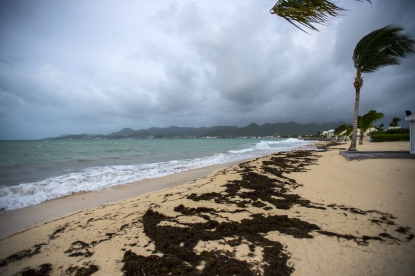 Waiting for Irma, Saint-Martin, September 5, 2017. (AFP / Lionel Chamoiseau)
Waiting for Irma, Saint-Martin, September 5, 2017. (AFP / Lionel Chamoiseau)


